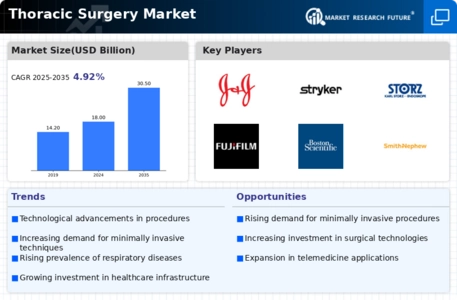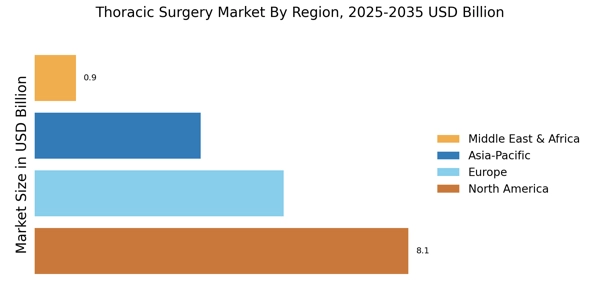Rising Incidence of Thoracic Diseases
The increasing prevalence of thoracic diseases, such as lung cancer and chronic obstructive pulmonary disease, is a primary driver of the Thoracic Surgery Market. According to recent data, lung cancer remains one of the leading causes of cancer-related deaths, with an estimated 2.2 million new cases diagnosed annually. This alarming statistic underscores the urgent need for surgical interventions, thereby propelling the demand for thoracic surgical procedures. As healthcare systems strive to address this growing burden, investments in thoracic surgery are likely to rise, enhancing the capabilities of medical professionals and improving patient outcomes. Furthermore, the aging population is expected to contribute to the rise in thoracic diseases, as older individuals are more susceptible to such conditions. This demographic shift may further stimulate the Thoracic Surgery Market, leading to advancements in surgical techniques and technologies.
Technological Advancements in Surgical Procedures
Technological innovations are transforming the landscape of the Thoracic Surgery Market. The integration of robotic-assisted surgery, advanced imaging techniques, and minimally invasive procedures has revolutionized thoracic surgery, enhancing precision and reducing recovery times. For instance, robotic-assisted thoracic surgery has gained traction, with studies indicating that it can lead to shorter hospital stays and lower complication rates compared to traditional methods. The market for surgical robots is projected to grow significantly, with estimates suggesting a compound annual growth rate of over 20% in the coming years. These advancements not only improve surgical outcomes but also attract more patients seeking less invasive options. As hospitals and surgical centers adopt these technologies, the Thoracic Surgery Market is likely to experience substantial growth, driven by the demand for innovative surgical solutions.
Growing Awareness and Education on Thoracic Health
The heightened awareness and education regarding thoracic health are significantly influencing the Thoracic Surgery Market. Public health campaigns and educational initiatives aimed at promoting lung health and early detection of thoracic diseases are becoming more prevalent. These efforts are likely to lead to earlier diagnoses and increased demand for surgical interventions. For instance, awareness programs about the risks of smoking and the importance of regular screenings have shown to improve early detection rates of lung cancer. As individuals become more informed about thoracic health, the likelihood of seeking surgical treatment increases, thereby driving the Thoracic Surgery Market. Furthermore, healthcare providers are increasingly focusing on patient education, which may enhance patient engagement and adherence to treatment plans, ultimately contributing to better surgical outcomes.
Increasing Investment in Healthcare Infrastructure
The ongoing investment in healthcare infrastructure is a crucial driver for the Thoracic Surgery Market. Governments and private entities are allocating substantial resources to enhance healthcare facilities, particularly in developing regions. This investment is aimed at improving access to advanced surgical procedures, including thoracic surgeries. For example, the establishment of specialized thoracic surgery centers is on the rise, providing patients with access to state-of-the-art technologies and skilled surgeons. Additionally, the expansion of healthcare facilities is expected to increase the number of surgical procedures performed, thereby boosting the Thoracic Surgery Market. As healthcare systems evolve, the focus on building robust infrastructure will likely facilitate the growth of thoracic surgery services, ultimately benefiting patient care and outcomes.
Emergence of Telemedicine in Surgical Consultations
The rise of telemedicine is emerging as a transformative force within the Thoracic Surgery Market. As healthcare providers adopt telehealth solutions, patients are gaining easier access to surgical consultations and follow-up care. This trend is particularly beneficial for individuals residing in remote areas, where access to specialized thoracic surgeons may be limited. Telemedicine facilitates timely consultations, enabling patients to receive expert opinions without the need for extensive travel. Moreover, the integration of telemedicine into surgical practices may lead to improved patient satisfaction and adherence to treatment protocols. As the acceptance of telehealth continues to grow, it is likely to influence the Thoracic Surgery Market positively, potentially increasing the number of patients seeking surgical interventions and enhancing overall healthcare delivery.


















Leave a Comment